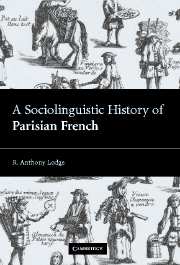Book contents
- Frontmatter
- Contents
- List of maps
- List of tables
- List of figures
- Acknowledgments
- List of phonetic symbols
- Part 1 Preliminaries
- Introduction
- 1 ‘The French of Paris’
- 2 The analytical frame
- Part 2 The pre-industrial city
- Part 3 The proto-industrial city
- Part 4 The industrial city
- Conclusion
- Appendix Literary imitations of low-class speech
- Bibliography
- Index
1 - ‘The French of Paris’
Published online by Cambridge University Press: 22 September 2009
- Frontmatter
- Contents
- List of maps
- List of tables
- List of figures
- Acknowledgments
- List of phonetic symbols
- Part 1 Preliminaries
- Introduction
- 1 ‘The French of Paris’
- 2 The analytical frame
- Part 2 The pre-industrial city
- Part 3 The proto-industrial city
- Part 4 The industrial city
- Conclusion
- Appendix Literary imitations of low-class speech
- Bibliography
- Index
Summary
Traditional approaches
The speech of the capital looms large in all histories of French, but the approach historians have adopted to it has, as a rule, been unidimensional. The expression le français de Paris is normally just a synonym for the standard language (= la langue littéraire, la langue nationale, la langue officielle and le français (tout court)), marginalising if not excluding the non-standard speech of the bulk of the city's inhabitants. Even historians known to adopt a distinctly ‘social’ approach to the French language look at Parisian French in this restricted way:
quand on dit langage de Paris, on ne dit pas le patois propre des habitants ignorants de la ville bornés à son seul horizon.
(Cohen 1987: 185)This is not to say that historians of French have been blind to the diversity of Parisian speech (see below, § 2.1). For instance, Ferdinand Brunot's monumental Histoire de la langue française (the HLF) examines a sizeable quantity of material on ‘popular’ speech in Paris (see in particular HLF III, 75ff.; VI.1, 1213–16; VI.2, 1860 and X.1, 259–70), but it treats it as a minor side-show beside the development of the standard. If eminent linguistic historians have hitherto taken a largely unidimensional view of ‘the French of Paris’, there must have been powerful reasons for it. We can group these under three headings: problems of data, the influence of prescriptivism and traditional models of linguistic variation and change.
- Type
- Chapter
- Information
- A Sociolinguistic History of Parisian French , pp. 5 - 16Publisher: Cambridge University PressPrint publication year: 2004

